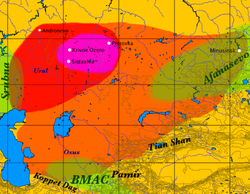Silesian
Junior Member
- Messages
- 738
- Reaction score
- 104
- Points
- 43
- Ethnic group
- Citizen of Earth.
- Y-DNA haplogroup
- R1b-BY593
- mtDNA haplogroup
- U5b2a2
Does any of the information from wiki prove or disprove your theories of Kurgan R1a Z 93/94 .invasion from steppe region. The stepp warriors who became farmers, did not leave many remains of their horses and chariots as of today; had gods representing oceans ?As for the chariots you were asking LeBrok about, read the Rig Veda yourself - there are good English language translations on the internet, and the chariot figures quite largely in the Rig Veda. There are lots of later Vedic material that mentions chariots, right up to the time the story of Krishna and Arjuna was written. Ever heard of Krishna's chariot?
Besides horses and chariots, have there been any weapons found in archeological sites, confirming your ideas; like arrowheads, spears, axes for example?
History
Proto-Indo-Iranians

The area of the spoke-wheeled chariot finds within the Sintashta-Petrovka culture is indicated in purple.
Development of the spoke-wheeled chariot is associated with the Proto-Indo-Iranians. The earliest fully developed war chariots known are from the chariot burials of the Andronovo (Timber-Grave) sites of the Sintashta-Petrovka culture in modern Russia and Kazakhstan dating from around 2000 BCE.
The chariot must not necessarily be regarded as a marker for Indo-European or Indo-Iranian presence.[2] According to Raulwing, it is an undeniable fact that only comparative Indo-European linguistics is able to furnish the methodological basics of the hypothesis of a "PIE chariot", in other words: "Ausserhalb der Sprachwissenschaft winkt keine Rettung![3]"[4][5]
The earliest evidence for chariots in southern Central Asia (on the Oxus) dates to the Achaemenid period (apart from chariots harnessed by oxen, as seen on petroglyphs).[6] No Andronovian chariot burial has been found south of the Oxus.[7]
Have there been any examples of barbaric conquest, by the Indo-Aryans from Andronovo, for example the Romans invaded Britain. Archeological finds.
http://www.bbc.com/news/uk-england-london-25744163Dozens of skulls excavated in London have provided the first evidence of a possible burial ground for Roman headhunting victims in the capital.




